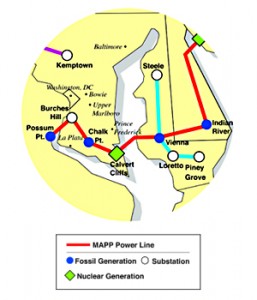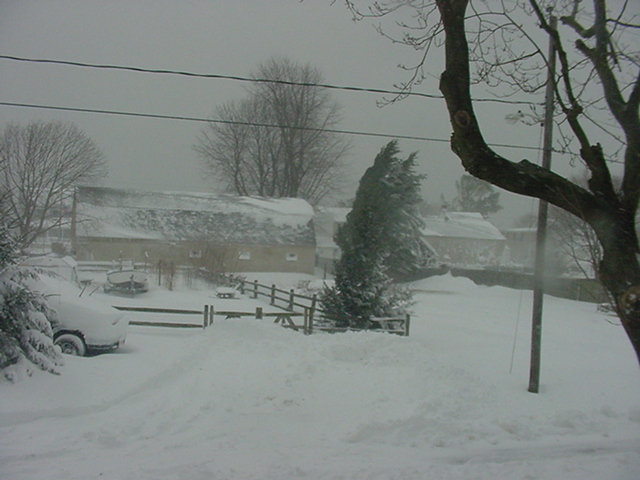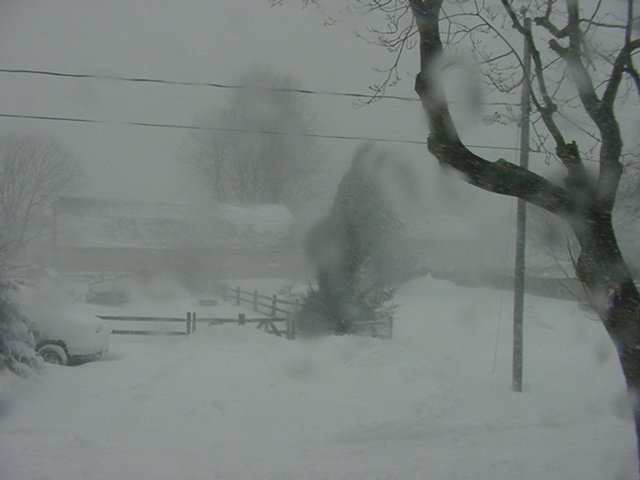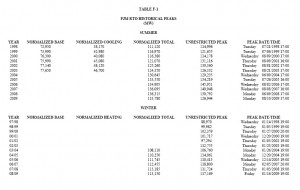PJM & PEPCO’s MAPP line trying to appease
May 9th, 2010
The MAPP line, PEPCO’s Mid-Atlantic Power Pathway transmission line project through Maryland and Delaware, is in the news again. But why??? Where the line is not needed, and it’s withdrawn by PJM and PEPCO, why is this being accepted? Why is this regarded as a “win?”
Remember that they pulled the project?
PEPCO letter 1.8.09 to suspend MAPP, includes 1.8.09 letter from PJM’s Herling
And before that, the part from Indian River to Salem was eliminated?
The May, 2009, Press Release says:
According to Gausman, PJM has also reviewed the need for the section of the line that would run from Delmarva Power’s Indian River substation near Millsboro, Del., to Salem, N.J., and has decided to move this portion of the line into its “continuing study” category. This means that the reconfigured MAPP line will now extend approximately 150 miles from northern Virginia, across southern Maryland and the Chesapeake Bay, and terminate at Indian River. The change would likely reduce the total project cost from $1.4 billion to $1.2 billion.
And then there’s the report that shows there’s no need, that demand is downdowndown, that “congestion” is downdowndown, that price of electricity is downdowndown, that demonstrates that the market concept that they’re all drooling over will have them aspirating their aspirations:
So then why did they send out a press release last week:
…which every Peninsula news outlet gave pretty much verbatim coverage?
And then there’s the PJM RTEP 2009, released February 26, 2010.
So here’s how their press release looks after the papers get it:
Delaware utilities: Plan takes power line under Choptank
It is being planned by Pepco Holdings Inc., parent company of Delmarva.
Now read the other “articles” and tell me if there’s an echo in the room:
Underwater power line route suggested
Proposal under Chesapeake avoids refuge
By Calum McKinney • Staff Writer • May 6, 2010
But the day before it was better, with some original quotes:
Snowpocalypse Now – Kady’s up to her belly in snow!
February 6th, 2010
Kady is from Georgia originally, though she spent almost a year on Long Island. She does NOT like snow. Today, Alan opened the door, and unlike Krie, she always calmly stands in the doorway and surveys her world, then CALMLY and SLOWLY walks down the stairs (what a dog!!). Today, as she surveyed the world, she looked up with a big “WTF” look!
She went down the shoveled path and with some encouragement went into the snow, over her belly. Some of the yard is almost bare, but some has pretty deep drifts, like 4′, and in the back corner up against the back door, all the windows have a curtain of snow, and the drift is 5-6 feet high. Official tallies are 21″ in Newark (DE), 20″ in Wilmington, 18″ in Bear, New Castle Airport 18″, Dover 15″ — snowfall totals predicted is now up to 24.5″ for NEW CASTLE COUNTY< @&” for Kent Count and 27″ for Sussex… though it doesn’t seem like much deeper than a foot overall here. It was very warm when it started so probably much of it melted. The numbers for accumulated snow are much lower in the south end of the peninsula, and it was over 30 when this all started.
This will shut down Delaware for a month! Time to underground those distribution lines, eh? Here, I’ve
Power’s out just about everywhere:
CLICK HERE for Delaware Electric Cooperative map
CLICK HERE for Delmarva Power outage map
TIME TO UNDERGROUND THE DISTRIBUTION LINES! Click on the Delmarva Power or DEC link, go to map and put cursor n location to see number of customers out of service. What I don’t get is the areas where there are so many more customers out of service than they have customers.
The view out the office window about 9 a.m.:
And now look at it… a couple hours later ~ 1 p.m.m it’s coming down, heavy thick blobs of snow, and it’s coming down FAST, none of this “winter wonderland” routine, it’s intense:
State of Delaware
Executive Department
DoverDECLARATION OF A STATE OF EMERGENCY
FOR THE STATE OF DELAWARE
DUE TO A SEVERE WINTER STORMWHEREAS, a severe winter storm with significant snowfall accumulations expected in all three counties of the State of Delaware, and blizzard conditions expected in Kent and Sussex counties has begun; and
WHEREAS, the predicted weather will likely create dangerous and life-threatening conditions and result in additional public safety responses from treacherous road conditions in all or parts of each county; and
WHEREAS, the weather conditions have the potential to cause additional safety issues to our citizens as well as damage and destruction to property; and
NOW THEREFORE, I, JACK A. MARKELL, pursuant to Title 20, Chapter 31 of the Delaware Code, do hereby declare a State of Emergency for the entire State of Delaware. This State of Emergency is effective at February 5, 2010 at 8 p.m. E.S.T. and continuing until terminated as provided under state law. The nature of the emergency is heavy snowfall, potentially high winds, whiteout conditions and minor to moderate coastal flooding. Along with such other actions authorized by Title 20, Chapter 31 of the Delaware Code, I specifically direct and authorize:
1.All departments and agencies of the State of Delaware shall assist in response and recovery activities, as directed by and in coordination with the Delaware Emergency Management Agency, in consultation with the Secretary of Safety and Homeland Security, necessary in those areas affected by the storm.
2. As of 10 p.m. February 5, 2010 and until further notice, no motor vehicles are to be operated on any road in the state of Delaware, unless such vehicles are being operated by authorized personnel responding to the State of Emergency or other emergency situations. Essential personnel who are traveling to assigned work locations for critical facilities operating on a 24/7 basis are exempt from this order and must carry credentials identifying them as employees of such facility. Private sector businesses are strongly urged to consider the safety of their employees and the restriction of travel during the storm when deciding whether to remain operating.
3. In order to enforce paragraph 2 of this Order, state and local officials are directed to remove abandoned vehicles from roads in the State of Delaware at the expense of the vehicle owner.
4. The Delaware National Guard shall take precautionary or responsive actions directed by the Director of the Delaware Emergency Management Agency, in consultation with the Secretary of Safety and Homeland Security, upon request by local authorities.
5. Government entities subject to bidding requirements are exempted from those bidding requirements for the purpose of purchasing materials necessary for responding to this snow and wind emergency.
6. I authorize the Delaware Department of Transportation and the Delaware State Police, in consultation with the Delaware Emergency Management Agency and the Secretary of Safety and Homeland Security, to order such bridge and road closures as necessary to protect the health and safety of the public.
7. The Delaware Emergency Management Agency shall activate the State Emergency Operations Plan and cooperate with federal entities in making applications, if necessary, for relief and assistance for those towns and communities adversely affected by snow, winds and coastal flooding, pursuant to the State Emergency Operations Plan of the State of Delaware and any potentially applicable federal disaster or emergency relief laws, including, but not limited to, the Stafford Disaster Relief and Emergency Assistance Act. The director of DEMA, or his designee, shall be the Governor’s Authorized Representative with respect to interaction with FEMA.
8. I reserve the right to take or direct state or local authorities to take, without issuance of further written order, any other necessary actions authorized by Title 20, Chapter 31 of the Delaware Code to respond to this emergency.
APPROVED this 5th day of February, 2010, at 4:45 p.m.
Jack A. Markell
Governor
That line’s going to fall in my living room…
January 24th, 2010
MID-Atlantic Power Pathway and all of PJM’s “backbone” projects in the news:
She’s worried about a larger line rising in the shadow of her house. If the poles somehow get knocked over, “Where’s that line going to fall? That line’s going to fall in my living room.
That’s Farah Morelli’s question. She’s a regular person who woke up one day with a monstrously large transmission line planned literally in her back yard. That’s usually the most effective way to get someone to learn about transmission. It’s a steep learning curve, and what I’ve found in my work with people in the path of proposed transmission is that once they start looking, they find a disturbing fact: Utilities propose transmission lines not because they’re “needed” but that they’re wanted, wanted to increase their ability to transmit and SELL cheap power in areas where it’s higher cost, and make a bundle in the process. It’s not that people don’t have electricity (and high price is the best instigator of conservation), but it’s that people want more and want it cheaper and the utilities which make $$$ from that equation want to make it happen.
HERE’S THE REALITY — The PJM 2010 Load Forecast Report and the Monitoring Analytics “PJM 3Q State of the Market” report show that this market decline isn’t anything new and that it’s not going away anytime soon. The PJM market peaked in 2006:
Today’s News Journal article is a start at pulling it all together, taking a look at the bigger picture, and that bigger picture is what these transmission lines are all about. Three lines were proposed together, the Potomac Allegheny Transmission Highline (PATH), the Mid-Atlantic Power Pathway (MAPP) and the Susquehanna-Roseland line. These aren’t just transmission lines, they’re BIG HONKIN’ ELECTRICAL AUTOBAHNS, quad (or now maybe tri?) bundled 500kV lines. Like WOW. HUGE!
Here’s today’s article:
Lower energy projections put brakes on power lines
Baltimore: Rally on Tuesday — say NO to transmission for coal!
November 29th, 2009
It’s so good to be home … for a second or so, that is, before the CapX 2020 Brookings public and evidentiary hearings start. For more on that, go to NoCapX 2020!
PJM’s Mid-Atlantic Power Pathway is in the news again… or is it PEPCO… or is it Delmarva Power… yes, another stupid transmission idea comin’ down the pike… it’s time to say NO! to transmission for coal!
Join the “No New Coal” brigade at the rally:
Baltimore’s Preston Gardens Park
Don’t get confused by this map of MAPP — they’re now admitting that the part from Indian River to Salem “isn’t needed” and it’s only a matter of time before they figure out that a 500kV line to nowhere isn’t needed either.

From The Diamondback, the University of Maryland’s paper – YES! maybe there’s hope, maybe they’ll do a better job than we have:
MAPP and PATH: Time to draw the line
Are people starting to get it? Here’s another from the Diamondback:
Guest column: Toppling King Coal
Krishna Amin is a junior biochemistry major. She can be reached at krish121 at umd dot edu.
Sussex County ponders Power Pathway
November 3rd, 2009
Sussex County has held off on taking a formal stand on Delmarva Power’s Mid-Atlantic Power Pathway, or MAPP, but Delmarva is pushing, so now’s the time to call them with a simple message:
No, don’t encourage and facilitate coal!
Say NO! to Delmarva Power’s Mid-Atlantic Power Path transmission proposal!
Delmarva Power is going around drumming up support for its Mid-Atlantic Power Pathway, or MAPP. They approached Sussex County to support the line (what do we know about that? Not much. Perhaps a FOIA to see what they’ve been doing is in order?) and because there’s a zoning matter before the County, they held off..
Delaware Electric Coop would like to use the MAPP line to bring in electricity from a new Old Dominion coal plant in Virginia. Oh… great idea… I’ve posted about this before:
Here’s Alan’s Green Delaware Alert and handout for DEC’s last annual meeting:
Building a coal plant is a really bad idea, and building transmission for coal is a really bad idea plus… two wrongs do not make a right.
Call all the County Council, thank them for putting on the brakes, and let them know what you think about Delmarva Power’s transmission for coal:
Michael H. Vincent (302) 629-2396
Samuel R. Wilson (302) 856-2972
Joan R. Deaver (302) 645-6657
George B. Cole (302) 539-1611
Vance C. Phillips (302) 542-1501
Here’s a report from the Cape Gazette:
Sussex County council delays support of transmission line
Pathway could pump $260 million in county’s economy
Moore responded with an emphatic yes.
He said anticipated savings are about 60 cents per month in charges related to congestion.






